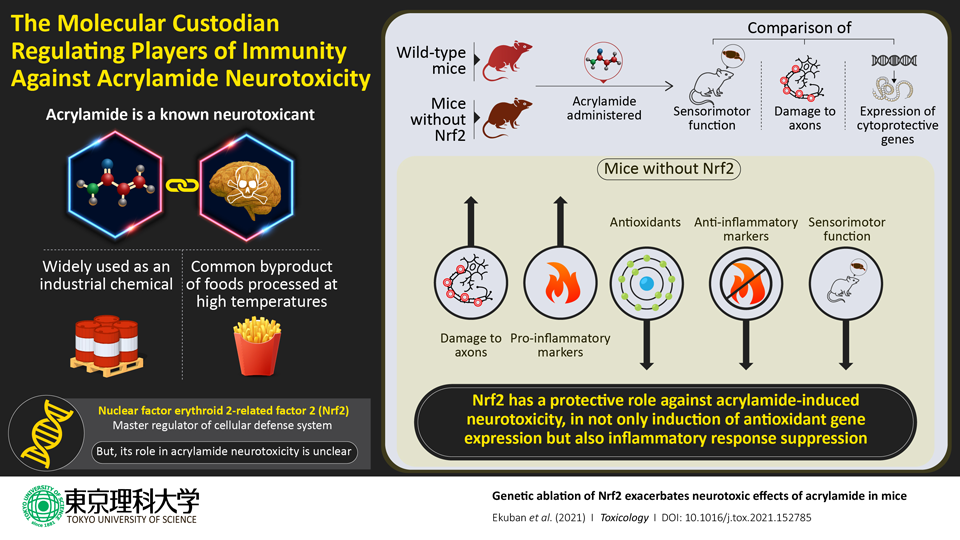2021.06.21 Monday
Nrf2: The Custodian Regulating Oxidative Stress and Immunity Against Acrylamide Toxicity
A study using genetically modified mice shows that a protein called Nrf2 increases the expression of protective genes in the acrylamide-induced toxic response
Acrylamide, which is extensively used in industries, causes peripheral neuropathy or encephalopathy. Now, scientists from Japan examined the response against oxidative stress in acrylamide-induced neurotoxicity and found that nuclear factor erythroid 2-related factor 2 (Nrf2), a master regulator of the immune system and response to oxidative stress, was at the center of this toxicity. They found that Nrf2 plays a protective role by increasing the expression of protective genes and decreasing that of pro-inflammatory genes.
 |
Acrylamide is a toxic chemical compound that affects the nervous system. Not only is it widely used in industries such as paper production, plastics, and wastewater management, but it is also a byproduct of commonly used food processing methods, which makes human exposure to acrylamide inevitable. Therefore, many studies have focused on understanding the toxic effects of acrylamide and our body's response to them. Generally, in response to toxicity, the body's cells release protective factors and antioxidants to remedy the damage. This response is activated by various cellular machinery. One such activator is a protein called "nuclear factor erythroid 2-related factor 2" (Nrf2), which is a master regulator of the response to oxidative stress and the immune system.
In a recent study, a team of scientists, led by Prof. Gaku Ichihara from Tokyo University of Science, reported the role of Nrf2 in acrylamide-induced neurotoxicity. Prof. Ichihara states, "Our study showed that Nrf2 has a protective role against neurologic damage and suggests it is through activation of antioxidant stress genes and suppression of proinflammatory cytokine genes."
In their study published in the journal Toxicology, Prof. Gaku Ichihara, along with his colleagues Prof. Masayuki Yamamoto from Tohoku University, Prof. Ken Itoh from Hirosaki University, Associate Prof. Seiichiroh Ohsako from The University of Tokyo, and Prof. Sahoko Ichihara from Jichi Medical University, used mice models to study the role of Nrf2 in acrylamide-induced neurotoxicity. They tested their hypothesis that when Nrf2 gene is removed, the neurotoxic effects of acrylamide will be amplified. For this, they developed "knockout" mice that could not produce Nrf2, and gave the Nrf2-knockout mice and a set of counterpart "wild-type" mice that could produce Nrf2 different concentrations of acrylamide for 4 weeks. Then, they compared the neurotoxicity between both groups of mice using various sensory and motor tests, immunohistochemistry, and protein and gene expression analyses.
The scientists found that the Nrf2-knockout mice had severe neurotoxic effects such as sensory and motor system dysfunction and axonal damage. While these mice produced fewer antioxidants and protective factors in response to acrylamide, they also showed enhanced release of pro-inflammatory chemicals, called "cytokines," in the brain, which can potentially cause additional damage. Additionally, as different doses were given to the mice, the scientists also determined that the neurotoxicity was dose-dependent.
Previous studies have established the role of Nrf2 as a master regulator of protective genes but this study explained the specific mechanisms of immune response to acrylamide-induced toxicity, with Nrf2 at the center of it all. As Prof. Ichihara states, "The results document the first known morphological and neuro-functional evidence of the regulatory role of Nrf2 in acrylamide-induced neurotoxic effects in mice."
The findings of this study are also immensely valuable in the field of disease biology, as recent studies have shown a link between air pollution and Alzheimer's disease. Since the air contains other acrylamide-like chemical pollutants with similar neurotoxic effects, the study's findings could prove useful in the prevention of Alzheimer's disease.
Prof. Ichihara and his team's study is certainly a timely one, as reports of acrylamide intoxication are on the rise and further research is required to better understand the specific mechanisms by which the body protects itself from harm.
Reference
| Title of original paper | : | Genetic ablation of Nrf2 exacerbates neurotoxic effects of acrylamide in mice |
| Journal | : | Toxicology |
| DOI | : | 10.1016/j.tox.2021.152785 |
About The Tokyo University of Science

Tokyo University of Science (TUS) is a well-known and respected university, and the largest science-specialized private research university in Japan, with four campuses in central Tokyo and its suburbs and in Hokkaido. Established in 1881, the university has continually contributed to Japan's development in science through inculcating the love for science in researchers, technicians, and educators.
With a mission of "Creating science and technology for the harmonious development of nature, human beings, and society", TUS has undertaken a wide range of research from basic to applied science. TUS has embraced a multidisciplinary approach to research and undertaken intensive study in some of today's most vital fields. TUS is a meritocracy where the best in science is recognized and nurtured. It is the only private university in Japan that has produced a Nobel Prize winner and the only private university in Asia to produce Nobel Prize winners within the natural sciences field.
About Professor Gaku Ichihara from Tokyo University of Science
Professor Gaku Ichihara is a faculty member at the Department of Occupational and Environmental Health at Faculty of Pharmaceutical Sciences, Tokyo University of Science. He graduated from School of Medicine, Nagoya University in 1988. In 2000, he received the Incentive Award from Japan Society for Occupational Health. He has also contributed to the field of nanotechnology. In 2013, he was the Chairperson of the 6th International Symposium on Nanotechnology, Occupational and Environmental Health. He has published more than 100 papers on his research interests: toxicology and occupational health.
https://www.tus.ac.jp/en/fac/p/index.php?6971 
Funding information
This work was supported by a Grant-in-Aid for Scientific Research from the Japan Society for the Promotion of Science (16H02965, 17H06396, 19H04279). F.A.E.'s PhD studies are funded by the Japanese Government Scholarship (MEXT).

